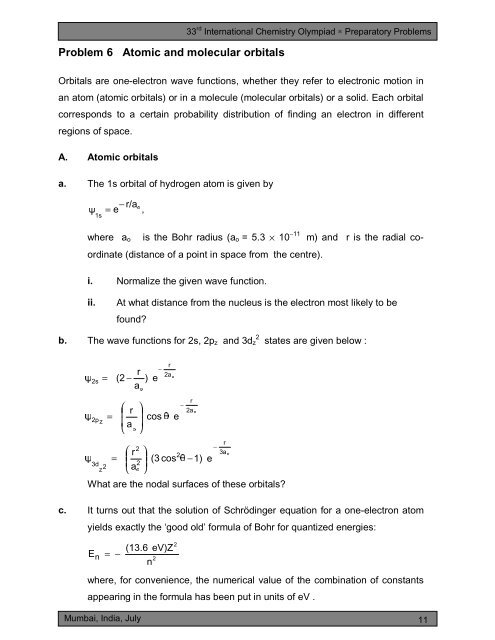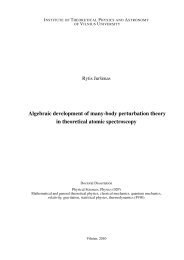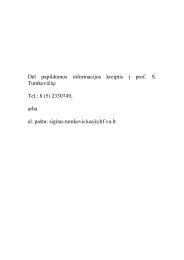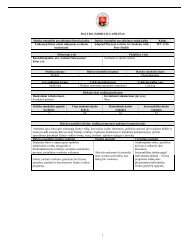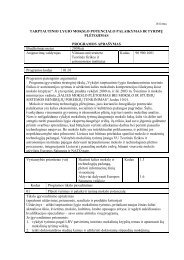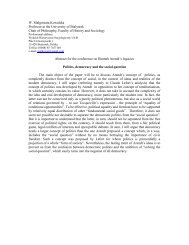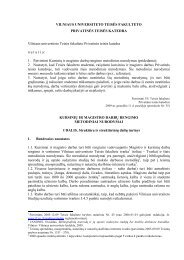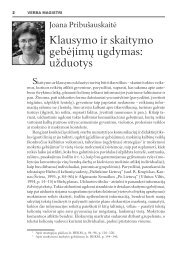Problem 6 Atomic and molecular orbitals - PianetaChimica.it
Problem 6 Atomic and molecular orbitals - PianetaChimica.it
Problem 6 Atomic and molecular orbitals - PianetaChimica.it
Create successful ePaper yourself
Turn your PDF publications into a flip-book with our unique Google optimized e-Paper software.
<strong>Problem</strong> 6 <strong>Atomic</strong> <strong>and</strong> <strong>molecular</strong> <strong>orb<strong>it</strong>als</strong>33 rd International Chemistry Olympiad ∗ Preparatory <strong>Problem</strong>sOrb<strong>it</strong>als are one-electron wave functions, whether they refer to electronic motion inan atom (atomic <strong>orb<strong>it</strong>als</strong>) or in a molecule (<strong>molecular</strong> <strong>orb<strong>it</strong>als</strong>) or a solid. Each orb<strong>it</strong>alcorresponds to a certain probabil<strong>it</strong>y distribution of finding an electron in differentregions of space.A. <strong>Atomic</strong> <strong>orb<strong>it</strong>als</strong>a. The 1s orb<strong>it</strong>al of hydrogen atom is given by− r/a= e% 1s$,where a o is the Bohr radius (a o = 5.3 × 10 −11 m) <strong>and</strong> r is the radial coordinate(distance of a point in space from the centre).i. Normalize the given wave function.ii.At what distance from the nucleus is the electron most likely to befound?b. The wave functions for 2s, 2p z <strong>and</strong> 3d z2states are given below :%%%2s2pz=3dz2==(2 −⎛⎜⎜⎝ra$⎛ r⎜⎝ ara2$⎞⎟⎟⎠2$)⎞⎟⎠er−2acos $(3 cose2r−2aWhat are the nodal surfaces of these <strong>orb<strong>it</strong>als</strong>?$−1)e−r3a$c. It turns out that the solution of Schrödinger equation for a one-electron atomyields exactly the ‘good old’ formula of Bohr for quantized energies:E n=−(13.6 eV)Z2n2where, for convenience, the numerical value of the combination of constantsappearing in the formula has been put in un<strong>it</strong>s of eV .Mumbai, India, July11 11
33 rd International Chemistry Olympiad ∗ Preparatory <strong>Problem</strong>sIt is fun using this formula for a neutral helium atom, but we must exercisesome care. In a helium atom, each electron ‘sees’ the nucleus screened bythe other electron. That is, the effective charge of the nucleus ‘seen’ by eachelectron decreases from <strong>it</strong>s bare value Z=2 to some other value, say, Z eff . Theionization energy for a helium atom in <strong>it</strong>s ground state is knownexperimentally to be 24.46 eV. Estimate Z eff .B. Molecular <strong>orb<strong>it</strong>als</strong>Molecular <strong>orb<strong>it</strong>als</strong> of a hydrogen molecule ion (H + 2 ) can be approximately wr<strong>it</strong>ten aslinear combinations of atomic <strong>orb<strong>it</strong>als</strong> centered around the two nuclei of themolecule. Consider the (unnormalized) <strong>molecular</strong> <strong>orb<strong>it</strong>als</strong> constructed in this mannerfrom the 1s <strong>and</strong> 2s <strong>orb<strong>it</strong>als</strong> of two hydrogen atoms, say, A <strong>and</strong> B:% % %% ~A B1 = 1s + 1sA B1 = %1s − %1sA B%2 = %2s + %2sA B% ~ 2 = % 2s − % 2sTaking the z-axis along the line joining the two nuclei, the orb<strong>it</strong>al contours of1are shown schematically below :% 1<strong>and</strong>% ~ 2ZY+−Similar orb<strong>it</strong>al contours (curves on which the value of ψ is constant) can be drawn for% 2<strong>and</strong> % ~ .The energies of these wave functions as a function of internuclear distance areshown below schematically:1212Mumbai, India, July 2001
33 rd International Chemistry Olympiad ∗ Preparatory <strong>Problem</strong>s−3.4 2~2E/eV 1~ 1−13.6−15.61.32R/10 −10a. Identify the bonding <strong>and</strong> antibonding <strong>orb<strong>it</strong>als</strong>. State qual<strong>it</strong>atively whatmakes one orb<strong>it</strong>al bonding <strong>and</strong> another antibonding.b. Determine the values of the equilibrium internuclear distance R e <strong>and</strong> thedissociation energy D of the ground state of H + 2 .c. If the <strong>molecular</strong> ion H + 2 is exc<strong>it</strong>ed to the state ψ2, to what atomic states will <strong>it</strong>dissociate?In the following questions, assume that the energy versus internuclear distancegraphs for the <strong>orb<strong>it</strong>als</strong> of H 2 <strong>and</strong> He 2 are similar to the one shown for H + 2 .d. Explain why the ground state total electron spin of the neutral H 2 molecule iszero.e. Wr<strong>it</strong>e down the electronic configuration of the first exc<strong>it</strong>ed state of H 2molecule. Predict if <strong>it</strong> will stay bound or dissociate.f. It is difficult to obtain He 2 in <strong>it</strong>s ground state, but <strong>it</strong> has been observed in <strong>it</strong>sexc<strong>it</strong>ed states. Explain how this is possible.<strong>Problem</strong> 7 Fissiona. Consider the following fission reactions of 235 U by thermal neutrons :23594140U + n → Sr + Xe + (.....)9238(...)23592U+ n →Mumbai, India, July14156Ba+(....)+3n13 13
33 rd International Chemistry Olympiad ∗ Preparatory <strong>Problem</strong>sIdentify the missing species <strong>and</strong> numbers.b. Consider the first of the reactions above. The unstable fission fragmentsundergo successive β-decays giving Zr <strong>and</strong> Ce. Wr<strong>it</strong>e down the net nuclearreaction <strong>and</strong> calculate the total energy released in MeV. You are given thefollowing data on atomic masses :m (m (m (mn235941401u =U) = 235.0493 uZr) = 93.9063 uCe) = 139.9054 u= 1.00866 u931.5 MeV/c2c. 1 kg of natural uranium metal was put in a nuclear research reactor. When thetotal energy released reached 1 Mega Watt Day (MWd), <strong>it</strong> was removed fromthe reactor. What would be the percentage abundance of 235 U in the uraniummetal at that time, if <strong>it</strong> is 0.72% in natural uranium. Your result in b. above maybe taken to be the average energy released per fission. Assume that all theenergy is due to fission of 235 U only.<strong>Problem</strong> 8 Radioactive decayThe radioactive isotope 210 Bi is the daughter product of 210 Pb <strong>and</strong> decays by β -emission to 210 Po, which is also radioactive. 210 Po decays by α-emission to the stable206 Pb.210 PbβT 1/2 = 22.3 y210 BiβT 1/2 = 5.01 d210 PoαT 1/2 = 138.4 d206 PbA sample of radiochemically pure 210 Bi was freshly isolated from 210 Pb <strong>and</strong> wasallowed to st<strong>and</strong> for the growth of 210 Po. The radioactiv<strong>it</strong>y of the freshly purified 210 Bisample was 100 µCi. (1 Ci = 3.7 x 10 10 disintegration per second)a. What is the in<strong>it</strong>ial mass of the sample ( 210 Bi)?b. Calculate the time <strong>it</strong> takes for the amount of 210 Po in the sample to grow to <strong>it</strong>smaximum value. How much is the maximum amount of 210 Po?1414Mumbai, India, July 2001
33 rd International Chemistry Olympiad ∗ Preparatory <strong>Problem</strong>sc. Determine the α-disintegration rate of 210 Po <strong>and</strong> β-disintegration rate of 210 Biat that time.<strong>Problem</strong> 9 Redox reactionsa. A solution containing Sn 2+ ions is t<strong>it</strong>rated potentiometrically w<strong>it</strong>h Fe 3+ . Thest<strong>and</strong>ard reduction potentials for Sn 4+/2+ <strong>and</strong> Fe 3+/2+ are given below.Sn 4+ + 2e - = Sn 2+ E° = 0.154 VFe 3+ + e - = Fe 2+ E° = 0.771 Vi. Wr<strong>it</strong>e down the overall reaction <strong>and</strong> calculate the st<strong>and</strong>ard free energychange of the overall reaction.ii.Determine the equilibrium constant of the reaction.b. If 20 mL of 0.10 M Sn 2+ is t<strong>it</strong>rated w<strong>it</strong>h 0.20 M Fe 3+ solution, calculate thevoltage of the celli. when 5 mL of Fe 3+ solution is added.ii.at the equivalence point.iii. when 30 mL Fe 3+ of the solution is added.The saturated calomel electrode (E° S.C.E = 0.242 V) is used as the referenceelectrode in the t<strong>it</strong>ration.c. One of the important analytical methods for estimation of Cu 2+ is iodometrict<strong>it</strong>ration. In this reaction Cu 2+ is reduced to Cu + by I − <strong>and</strong> the liberated I 2 isthen t<strong>it</strong>rated w<strong>it</strong>h st<strong>and</strong>ard Na 2 S 2 O 3 solution. The redox reaction is as follows:2Cu 2+ + 4I − → 2CuI (s) + I 2 (aq)Electrode potentials of the relevant half-cells are:Cu 2+ + e - = Cu + E° = 0.153 VI 2 + 2e - = 2I − E° = 0.535 VMumbai, India, July15 15
33 rd International Chemistry Olympiad ∗ Preparatory <strong>Problem</strong>sA consideration of the electrode potentials would indicate that reduction of Cu 2+ by I −is not a spontaneous reaction. However, in the iodometric t<strong>it</strong>ration this reaction doestake place. Let us try to underst<strong>and</strong> the anomaly:i. CuI has low solubil<strong>it</strong>y in water w<strong>it</strong>h K sp ≈ 1.1× 10 −12 . Calculate theeffective E° value for the equilibrium CuI (s) = Cu + + I − .ii.iii.Using the result in i., calculate the effective E° value for the reductionof Cu 2+ by I − . What does this value suggest about the spontane<strong>it</strong>y ofthe reaction?Calculate the equilibrium constant of the reduction reaction in ii.<strong>Problem</strong> 10 Solubil<strong>it</strong>y of sparingly soluble saltsTwo important factors that affect the solubil<strong>it</strong>y of a sparingly soluble salt are pH <strong>and</strong>the presence of a complexing agent. Silver oxalate is one such salt, which has lowsolubil<strong>it</strong>y in water (2.06 x 10 −4 at pH = 7.0). Its solubil<strong>it</strong>y is affected by pH as theanion oxalate reacts w<strong>it</strong>h hydronium ions, <strong>and</strong> also by a complexing agent such asammonia as the cation silver forms complexes w<strong>it</strong>h ammonia.a. Calculate the solubil<strong>it</strong>y of silver oxalate in acidified water w<strong>it</strong>h pH = 5.0. Thefirst <strong>and</strong> second dissociation constants for oxalic acid are 5.6 x 10 −2 <strong>and</strong> 6.2 x10 −5 respectively.b. In the presence of ammonia in aqueous solution, silver ion forms twocomplexes Ag(NH 3 ) + <strong>and</strong> Ag(NH 3 ) + 2 . The values of the stepwise stabil<strong>it</strong>yconstants for the formation of these complexes are 1.59 x 10 3 <strong>and</strong> 6.76 x 10 3 .What is the solubil<strong>it</strong>y of silver oxalate in an aqueous solution that contains0.02 M NH 3 <strong>and</strong> has pH = 10.8?<strong>Problem</strong> 11 Spectrophotometrya. Manganese <strong>and</strong> chromium in steel can be determined simultaneously byabsorption spectral method. Dichromate <strong>and</strong> permanganate ions in 1M H 2 SO 4(Cr 2 O 2− 7 <strong>and</strong> MnO − 4 ) absorb at 440nm <strong>and</strong> 545nm. At these wavelengths,−molar absorptiv<strong>it</strong>y of MnO 4 is 95 Lmol −1 cm −1 <strong>and</strong> 2350 Lmol −1 cm −1respectively <strong>and</strong> that of Cr 2 O 2− 7 is 370 Lmol −1 cm −1 <strong>and</strong> 11 Lmol −1 cm −1respectively.1616Mumbai, India, July 2001
33 rd International Chemistry Olympiad ∗ Preparatory <strong>Problem</strong>sA steel sample, weighing 1.374g was dissolved <strong>and</strong> Mn <strong>and</strong> Cr in the resulting−solution oxidised to MnO 4 <strong>and</strong> Cr 2 O 2− 7 . The solution was diluted w<strong>it</strong>h 1MH 2 SO 4 to 100.0mL in a volumetric flask. The transm<strong>it</strong>tances of this solutionwere measured w<strong>it</strong>h a cell of 1.0cm path length <strong>and</strong> w<strong>it</strong>h 1.0M H 2 SO 4 asblank. The observed transm<strong>it</strong>tances at 440nm <strong>and</strong> 545nm respectively were35.5% <strong>and</strong> 16.6%.Calculate from these data the percentage of Mn <strong>and</strong> Cr in the steel sample.Assume that Beer’s law is valid for each ion <strong>and</strong> that the absorption due toone ion is unaffected by the presence of the other ion .b. Cobalt (II) forms a single complex CoL 2+ 3 w<strong>it</strong>h an organic lig<strong>and</strong> L <strong>and</strong> thecomplex absorbs strongly at 560nm. Ne<strong>it</strong>her Co(II) nor lig<strong>and</strong> L absorbs atthis wavelength. Two solutions w<strong>it</strong>h the following compos<strong>it</strong>ions were prepared:Solution 1 [Co(II)] = 8 x 10 −5 <strong>and</strong> [L] = 2 x 10 −5 .Solution 2 [Co(II)] = 3 x 10 −5 <strong>and</strong> [L] = 7 x 10 −5 .The absorbances of solution 1 <strong>and</strong> solution 2 at 560nm, measured w<strong>it</strong>h a cellof 1.0cm path length, were 0.203 <strong>and</strong> 0.680 respectively. It may be assumedthat in solution 1, all the lig<strong>and</strong> is consumed in the formation of the complex.From these data calculate the2+i. molar absorptiv<strong>it</strong>y of the complex CoL 3ii. stabil<strong>it</strong>y constant for the formation of the complex CoL 2+ 3 .<strong>Problem</strong> 12 Reactions in buffer mediumAn organic n<strong>it</strong>ro-compound (RNO 2 ) is electrolytically reduced in an aqueous acetatebuffer solution having total acetate concentration (HOAc + OAc − ) 0.500 <strong>and</strong> pH = 5.0.300 mL of the buffered solution containing 0.01M RNO 2 was reduced completely. Thedissociation constant for acetic acid is 1.75 x 10 −5 at 25 °C. The reduction reaction isRNO 2+ 4H + + 4e - RNHOH + H 2OCalculate the pH of the solution on completion of the reduction of RNO 2 .Mumbai, India, July17 17
33 rd International Chemistry Olympiad ∗ Preparatory <strong>Problem</strong>s<strong>Problem</strong> 13 Identification of an inorganic compoundSome observations related to an unknown inorganic substance A are presentedbelow.♦ A is a yellowish – wh<strong>it</strong>e deliquescent solid <strong>and</strong> <strong>it</strong> sublimes on heating. It has a<strong>molecular</strong> weight of 266.♦ A reacts violently w<strong>it</strong>h water, forming solution B.♦ When a solution of NH 4 Cl <strong>and</strong> NH 4 OH is added to solution B, a wh<strong>it</strong>e gelatinousprecip<strong>it</strong>ate is obtained.♦ A sample of B also gives a curdy wh<strong>it</strong>e precip<strong>it</strong>ate C on add<strong>it</strong>ion of dilute n<strong>it</strong>ricacid <strong>and</strong> silver n<strong>it</strong>rate solution. This wh<strong>it</strong>e precip<strong>it</strong>ate C readily dissolves whendilute NH 4 OH is added, though a gelatinous wh<strong>it</strong>e precip<strong>it</strong>ate D is formed in <strong>it</strong>splace w<strong>it</strong>h excess NH 4 OH.♦ Precip<strong>it</strong>ate D is filtered off <strong>and</strong> is dissolved in excess NaOH to give a clearsolution E.♦ When CO 2 is passed through solution E, compound D is reprecip<strong>it</strong>ated.♦ Substance A dissolves unchanged in dry ether. When this solution is reacted w<strong>it</strong>hLiH, a product F is formed. If LiH is used in excess, F transforms to G.a. Identify the unknown compound A.b. Wr<strong>it</strong>e down the appropriate chemical equations for the given reactions <strong>and</strong>identify the different products from B to G.<strong>Problem</strong> 14 Ionic <strong>and</strong> metallic structuresModern methods of structural analysis using X-rays provide valuable informationabout the three dimensional arrangement of atoms, molecules or ions in a givencrystal structure.1818Mumbai, India, July 2001
33 rd International Chemistry Olympiad ∗ Preparatory <strong>Problem</strong>sa. Crystal structure of rock salt (NaCl) is given below.i. What is the type of crystal lattice presented in the diagram?ii.iii.iv.What is the coordination number of a sodium ion in this structure?What is the number of formula un<strong>it</strong>s of NaCl per un<strong>it</strong> cell?Calculate the r Na + / r Cl − lim<strong>it</strong>ing radius ratio for this structure.v. Why is the array of chloride ions slightly exp<strong>and</strong>ed, w<strong>it</strong>h the nearestCl-Cl distance being 400pm, compared to the close packed value of362 pm?vi.vii.What happens when the cation radius in the structure shown above isprogressively increased till the cation/anion radius ratio reaches avalue of 0.732?What is the range of cation/anion radius ratio for which the structurelike that of NaCl is stable?b. The Cu - K α X-ray(λ = 154pm) reflection from (200) planes of sodium chloridecrystal is observed at 15.8°. Given that the radius of the chloride ion is 181pm, calculatei. the separation between adjacent 200 planes of NaCl.ii.iii.the length of the un<strong>it</strong> cell edge (lattice constant) of NaCl.the radius of the sodium ion.Mumbai, India, July19 19
33 rd International Chemistry Olympiad ∗ Preparatory <strong>Problem</strong>sc. The diagram of a cubic close packing (ccp) <strong>and</strong> a hexagonal close packing(hcp) lattice arrangement (assuming rigid sphere model) is given below.i. Describe the difference between the ccp <strong>and</strong> hcp lattice arrangements.ii.iii.Calculate the packing fraction for a ccp arrangement.Will the coordination number, <strong>and</strong> the packing fraction in a hcparrangement be the same as that in a ccp arrangement?d. Nickel (at.wt. 58.69) crystallizes in the ccp structure. X-ray diffraction studiesindicate that <strong>it</strong>s un<strong>it</strong> cell edge length is 352.4 pm. Given that the dens<strong>it</strong>y ofNickel is 8.902 g cm -3 , calculatei. the radius of the nickel atom.ii.iii.the volume of the un<strong>it</strong> cell.the Avogadro number.<strong>Problem</strong> 15 Compounds of n<strong>it</strong>rogena. N<strong>it</strong>rogen forms a number of oxides. One of the important oxides of n<strong>it</strong>rogen isNO 2 , a red-brown colored reactive gas.2020Mumbai, India, July 2001
33 rd International Chemistry Olympiad ∗ Preparatory <strong>Problem</strong>si. Draw the Lewis structure of NO 2 <strong>and</strong> predict <strong>it</strong>s shape using valenceshell electron pair repulsion theory.ii. Using VSEPR, predict the shapes of the NO − 2 <strong>and</strong> NO + 2 ions. Comparethe shapes of these two ions w<strong>it</strong>h that of NO 2 .b. Consider two other compounds of n<strong>it</strong>rogen, trimethylamine (Me 3 N) <strong>and</strong>trisilylamine (H 3 Si) 3 N. The observed bond angles at n<strong>it</strong>rogen in thesecompounds are 108° <strong>and</strong> 120° respectively. Explain the difference in the bondangles.c. Both n<strong>it</strong>rogen <strong>and</strong> boron form trifluorides. The bond energy in BF 3 is 646kJ/mole <strong>and</strong> that in NF 3 is only 280 kJ/mole. Account for the difference inbond energies.d. The boiling point of NF 3 is –129°C while that of NH 3 is –33°C. Ammonia actsas a Lewis base whereas NF 3 does not. The observed dipole moment of NF 3(0.24 D) is much less than that of NH 3 (1.46 D), even though fluorine is muchmore electronegative than hydrogen.i. Explain the differences between boiling points <strong>and</strong> basic<strong>it</strong>ies of NF 3<strong>and</strong> NH 3 .ii. Account for the low dipole moment of NF 3.e. The reaction of aqueous sodium n<strong>it</strong>rate w<strong>it</strong>h sodium amalgam as well as thatof ethyl n<strong>it</strong>r<strong>it</strong>e w<strong>it</strong>h hydroxylamine in presence of sodium ethoxide give thesame product. This product is the salt of a weak unstable acid of n<strong>it</strong>rogen.Identify the acid <strong>and</strong> wr<strong>it</strong>e down <strong>it</strong>s structure. This acid isomerises into aproduct, which finds use in propellant formulations. Wr<strong>it</strong>e the structure of theisomer.Mumbai, India, July21 21
33 rd International Chemistry Olympiad ∗ Preparatory <strong>Problem</strong>s<strong>Problem</strong> 16 Structure elucidation w<strong>it</strong>h stereochemistryC<strong>it</strong>ric acid (2-hydroxy-1,2,3-propanetricarboxylic acid) is the primary acid of c<strong>it</strong>rusfru<strong>it</strong>s, which contributes to their sour taste. Commercial manufacturing of c<strong>it</strong>ric acidinvolves fermentation of molasses or starch using the fungus Aspergillus niger at pH3.5. It is widely used in food, soft drinks <strong>and</strong> as a mordant in dyeing. It is also animportant biochemical intermediate.a. What transformation will c<strong>it</strong>ric acid undergo when warmed w<strong>it</strong>h concentratedsulfuric acid at 45-50°C? Give the structure <strong>and</strong> IUPAC name of the productobtained. Which type of organic acids would undergo a similar reaction?After warming c<strong>it</strong>ric acid w<strong>it</strong>h sulfuric acid, anisole (methoxybenzene) is added to thereaction mixture <strong>and</strong> product A (C 12 H 12 O 5 ) is obtained.ƒOn heating w<strong>it</strong>h acetic anhydride, A forms an anhydride.ƒ118 mg of A requires 20 mL of 0.05 N KOH for neutralisation.ƒ Reaction w<strong>it</strong>h bromine indicates that the same amount of compound A requires80 mg of bromine, to give an add<strong>it</strong>ion product.b. Deduce the structure of A.c. Identify the possible isomers of A in this reaction <strong>and</strong> give their structures,absolute configurations <strong>and</strong> the IUPAC names.d. In the bromination reaction, how many stereoisomers of A will be obtained?Draw their Fischer projections.e. Assign absolute configurations to the stereocentres in all the stereoisomersformed in d.Instead of anisole, if phenol <strong>and</strong> resorcinol are separately added to the reactionmixture, compounds B <strong>and</strong> C are obtained, respectively. B does not give anycoloration w<strong>it</strong>h neutral FeCl 3 , but C does. Under identical reaction cond<strong>it</strong>ions, theyield of compound C is much higher than that of B.2222Mumbai, India, July 2001
33 rd International Chemistry Olympiad ∗ Preparatory <strong>Problem</strong>sf. Give appropriate structures for B <strong>and</strong> C.g. What is the difference between the reactions leading to the formation of A <strong>and</strong>B?h. Why is the yield of C higher than that of B?<strong>Problem</strong> 17 Organic spectroscopy <strong>and</strong> structure determinationThe following observations were recorded for identifying two compounds A <strong>and</strong> B.Both have the <strong>molecular</strong> formula C 3 H 6 O. Schematic 1 H-NMR spectra of thesecompounds at 400 MHz are presented in the following figure. The peak pos<strong>it</strong>ions <strong>and</strong>the relative intens<strong>it</strong>ies of the different lines in the 1 H-NMR spectrum of B are given inthe accompanying Table (Note: the values have been altered slightly from theexperimental values to facil<strong>it</strong>ate analysis.)One of these compounds reacts w<strong>it</strong>h malonic acid to form a compound known asMeldrum's acid, w<strong>it</strong>h the <strong>molecular</strong> formula C 6 H 8 O 4 , which gives peaks between 0 <strong>and</strong>7.0 δ in <strong>it</strong>s 1 H-NMR spectrum. The IR spectrum shows a peak in the region 1700 - 1800cm -1 . It condenses w<strong>it</strong>h an aromatic aldehyde in the presence of a base.AB765 4 3 2chemical shift (δ)101 H-NMR schematic spectra of A <strong>and</strong> B at 400 MHzMumbai, India, July23 23
33 rd International Chemistry Olympiad ∗ Preparatory <strong>Problem</strong>sPeak pos<strong>it</strong>ions <strong>and</strong> relative intens<strong>it</strong>ies of individual lines in the 1 H NMRspectrum (400 MHz) of BLine (ppm) Relativeintens<strong>it</strong>yLine (ppm) Relativeintens<strong>it</strong>y1 6.535 1 8 3.870 12 6.505 1 9 3.525 13 6.495 1 10 3.505 14 6.465 1 11 3.495 15 3.930 1 12 3.475 16 3.910 1 13 3.000 127 3.890 1a. Label the unknown compounds in the bottles w<strong>it</strong>h IUPAC names, using theNMR spectra given in the figure.b. In the 1 H-NMR spectrum of B, assign the peak pos<strong>it</strong>ions to specific protons.c. Calculate the spin-spin coupling constants for protons of compound B.d. Convert the peak pos<strong>it</strong>ions of the first four lines into Hz (refer to theTable).What will be the peak pos<strong>it</strong>ions of these lines in Hz, if the spectrum isrecorded on a 600 MHz instrument?e. Draw the possible structure of Meldrum's acid.f. Meldrum's acid has pK a = 4.83. Explain the acid<strong>it</strong>y of Meldrum’s acid.g. Give the structure of the condensation product of Meldrum's acid w<strong>it</strong>h anaromatic aldehyde.2424Mumbai, India, July 2001
<strong>Problem</strong> 18 Polymer synthesis33 rd International Chemistry Olympiad ∗ Preparatory <strong>Problem</strong>sEthylene finds extensive application in the manufacture of polymers <strong>and</strong> bulkchemicals. It is produced on a large scale by thermal <strong>and</strong> catalytic cracking ofalkanes obtained from natural gas <strong>and</strong> petroleum.In the presence of silver catalyst, ethylene reacts w<strong>it</strong>h oxygen to give P. CompoundP on heating w<strong>it</strong>h acidified water forms Q. 1 H-NMR spectrum of P has only onesignal while that of Q contains two signals.a. Identify <strong>and</strong> draw the structures for compounds P <strong>and</strong> Q.Compound R is obtained when P <strong>and</strong> Q react w<strong>it</strong>h each other. R reacts w<strong>it</strong>h SOCl 2to give S. On heating w<strong>it</strong>h alcoholic KOH, S gives T, an anaesthetic under the name"vinethene".PSOCl 2alc.KOH+ QR S Tb. Identify compounds R, S <strong>and</strong> T.Another compound dimethyl benzene-1,4-bis(acetate) can be synthesised fromp-xylene. Such a synthesis requires use of proper reagents so that desiredintermediate compounds <strong>and</strong> the final product are obtained. Various intermediatecompounds obtained in the synthesis of dimethyl benzene-1,4-bis(acetate) alongw<strong>it</strong>h their structures are shown below.COOHCOOCH 3CH 3CH 2BrCH 2CNCH 2CH 2??? ?????CH 3CH 2BrCH 2CNCH 2CH 2p-xyleneCOOHCOOCH 3Dimethyl benzene -1,4 -bisacetatec. Identify the reagents used in this synthesis of dimethyl benzene –1,4-bis(acetate).Mumbai, India, July25 25
33 rd International Chemistry Olympiad ∗ Preparatory <strong>Problem</strong>sd. How many peaks would you expect in the 1 H-NMR spectrum of dimethylbenzene –1,4-bis(acetate)?When dimethyl benzene-1,4-bis(acetate) (synthesised from p-xylene) <strong>and</strong> compoundR (obtained from ethylene) are heated together a polymer is formed.e. Draw the structure of the polymer.f. What happens when this polymer is treated w<strong>it</strong>hƒ aq KOH (heat), then H + / H 2 O?ƒ LiAlH 4 ?g. Inadvertently, an excess of dimethyl benzene-1,4-bis(acetate) was heatedw<strong>it</strong>h glycerol <strong>and</strong> a different polymer was obtained. What is the likely structureof this polymer? Will <strong>it</strong> be su<strong>it</strong>able for drawing fibres?<strong>Problem</strong> 19 Organic synthesis involving regioselectionOne crucial problems in organic synthesis concerns the synthesis of a specificdisubst<strong>it</strong>uted benzene through an electrophilic subst<strong>it</strong>ution reaction on amonosubst<strong>it</strong>uted benzene. This problem is elegantly tackled in a synthesis ofTramadol, an analgesic drug (C 16 H 25 NO 2 ), described below. The first step in thissynthesis invovles :PhenolHSbF 6halogenAA gives two equal intens<strong>it</strong>y peaks at 172 <strong>and</strong> 174 in the highest m/z region of <strong>it</strong>smass spectrum. It gives a mixture of three isomeric monon<strong>it</strong>ro derivatives on n<strong>it</strong>rationunder mild cond<strong>it</strong>ions.a. Draw the structure for compound A. What is the regioselection observed inthe reaction of phenol to form A? State the significance of this reaction.2626Mumbai, India, July 2001
Consider the following reaction33 rd International Chemistry Olympiad ∗ Preparatory <strong>Problem</strong>sA( CH 3) 2SO 4/ NaOHBMg / THF / tolueneCMass spectrum of B shows equal intens<strong>it</strong>y peaks at 186 <strong>and</strong> 188 in the highest m/zregion.b. Give structures of compounds B <strong>and</strong> C. How does the reactiv<strong>it</strong>y of B changeon <strong>it</strong>s conversion to C?Another intermediate compound D required for the synthesis of Tramadol is obtainedas followsCyclohexanoneparaformaldehydedimethylamineD ( C 9H 17NO )( Dissolves in HCl )C+ D[ E ]hydrolysisTramadolc. Show the structures of compound D <strong>and</strong> the final product Tramadol.d. Give the structures of the possible stereoisomers of Tramadol.<strong>Problem</strong> 20 Carbon acidsKeto esters are bifunctional reactive molecules <strong>and</strong> are important synthons for thesynthesis of aliphatic <strong>and</strong> heterocyclic compounds.a. Two isomeric keto esters X <strong>and</strong> Y have the same <strong>molecular</strong> formula C 5 H 8 O 3 .Deduce their possible structuresEach ester is first reacted w<strong>it</strong>h benzyl bromide in the presence of CH 3 ONa, <strong>and</strong> theresulting products are treated w<strong>it</strong>h 1 or 2 equivalent of a strong base (such as l<strong>it</strong>hiumdiisopropyl amide, LDA) followed by 1 equivalent of CH 3 I.The products at the end of the second step are then hydrolysed by aq.HCl.b. Wr<strong>it</strong>e down the reaction sequences involved.Mumbai, India, July27 27
33 rd International Chemistry Olympiad ∗ Preparatory <strong>Problem</strong>sc. At the end of the reaction, the final product of keto ester X is a neutralcompound (<strong>molecular</strong> formula C 11 H 14 O) whereas keto ester Y, gives a ketoacid (<strong>molecular</strong> formula C 12 H 14 O 3 ). Explain.d. Keto ester X gives different products depending upon the amount of LDAused. Explain what happens wheni. 1 equivalent of LDA is used.ii.2 equivalents of LDA are used.<strong>Problem</strong> 21Amino acids <strong>and</strong> enzymesAmino acids are the building blocks of proteins. The presence of –NH 2 <strong>and</strong> -COOHgroups makes amino acids amphoteric in nature. Certain amino acid side chains inproteins are cr<strong>it</strong>ically important for their reactiv<strong>it</strong>y <strong>and</strong> catalytic role. Glutamic acid isone such amino acid, whose structure is shown below.( pKa = 9.7 )-COO ( pKa = 2.2 )H 3N + CHCH 2CH 2-COO( pKa = 4.3 )a. Why is the pK a of the α-COOH group lower than that of the γ-COOH ?b. Calculate the percent of γ-COOH group that remains unionized at pH 6.3.c. Glutamic acid is subjected to paper electrophoresis at pH = 3.25. Will <strong>it</strong> movetowards the anode (+) or cathode (-) ? Why ?Hydrolysis of polysaccharides like ch<strong>it</strong>in, cellulose <strong>and</strong> peptidoglycan is a commonbiochemical process. This involves the hydrolysis of a glycosidic bond like the β-1, 4linkage shown below.2828Mumbai, India, July 2001
33 rd International Chemistry Olympiad ∗ Preparatory <strong>Problem</strong>sAOBOOC O1C 4β-1, 4 linkageOne such hydrolysis reaction is catalysed by lysozyme.d. Suppose the lysozyme catalyzed reaction is performed in 18 O enriched water,do you expect the 18 O to be incorporated into the product? If yes, where?The pH-activ<strong>it</strong>y profile of lysozyme is shown in the figureRelative Activ<strong>it</strong>y( % )3 5 7pHe. Explain this pH behavior in terms of two carboxylates (Asp-52 <strong>and</strong> Glu-35)present at the lysozyme active s<strong>it</strong>e (note : ionizable groups on the substrate arenot involved). Wr<strong>it</strong>e the ideal state of ionization at the lysozyme active s<strong>it</strong>e atpH 5.0.f. The pK a of Glu-35 in lysozyme active s<strong>it</strong>e is 6.0 <strong>and</strong> not 4.3 as found in the freeamino acid. Which of the following local effects is likely to be involved?1. Enhanced negative chargeMumbai, India, July29 29
33 rd International Chemistry Olympiad ∗ Preparatory <strong>Problem</strong>s2. Enhanced pos<strong>it</strong>ive charge3. Enhanced polar<strong>it</strong>y4. Diminished polar<strong>it</strong>yOrganic model reactions have helped to underst<strong>and</strong> many features of enzymecatalytic mechanisms. When a reaction is made intra<strong>molecular</strong> (like the enzymecatalysts do!), rate acceleration takes place as if the apparent reactant concentrationfelt at the s<strong>it</strong>e is enormously raised. The carboxylate group assisted hydrolysis ofthree phenylacetates <strong>and</strong> their rate constants (k) are shown below.(1)OH 3C C+OH 3C-COO-1k 1 = 0.002 s-(when [ CH 3COO ] =1 M )(pseudo first order)(2)OCOk 2= 0.4 s-1COO -(first order)(3)OC Ok 3= 20 s -1COO - (first order)g. Calculate the effective local concentration of the COO - group felt in (2) <strong>and</strong> (3)above.h. Why do you see a higher rate in (3) than in (2) ?3030Mumbai, India, July 2001
<strong>Problem</strong> 22 Coenzyme chemistry33 rd International Chemistry Olympiad ∗ Preparatory <strong>Problem</strong>sThe protective outer cell wall in bacteria has D-alanine as one of the building blocks.However, metabolically only L-amino acids are available. Bacteria make D-alanine byinverting the L-alanine. The structure of L-alanine is given below :HMeCOOHNH 2L-alanineThe abstraction of α-proton from L-alanine <strong>and</strong> reprotonation of the resultantcarbanion from the oppos<strong>it</strong>e side appears to be a simple process. However, <strong>it</strong> is noteasy to deprotonate alanine unless <strong>it</strong>s NH 2 group is masked <strong>and</strong> C α -H is activated asan acid.Both these steps are brought about by the coenzyme pyridoxal phosphate (PLP) inthe presence of the enzyme alanine racemase. The following observations made incertain model reactions will help you appreciate the role of PLP as the coenzyme.Under favorable experimental cond<strong>it</strong>ions, benzaldehyde can be used as a reagent toracemize alanine. In other words, <strong>it</strong> can mask the amine group <strong>and</strong> activate the C α -H of alanine making <strong>it</strong> more acidic.CHOL-alanineD / L-alanineBasea. Propose a stepwise mechanism for this base catalyzed racemisation of L-alanine involving benzaldehyde as the reagent.Compared to benzaldehyde, PLP is a somewhat complex molecule. W<strong>it</strong>h the help ofa few carefully designed aromatic aldehydes, good insight about the role of PLP as acoenzyme can be obtained.Mumbai, India, July31 31
33 rd International Chemistry Olympiad ∗ Preparatory <strong>Problem</strong>sA few relevant structures are presented below. Underneath each, there is anindication about <strong>it</strong>s activ<strong>it</strong>y.-OOPOHOCHOOH+ NHMeHOCHOOH+ NHMePLP (1)ActivePyridoxal (2)ActiveC H 3CHOOHOCHOOCH 3+ NHMe+ NHMe(3)Active(4)InactiveHOCHOOHHOCHOOHNO 2O 2NNO 2(5)Active(6)Inactiveb. Based on this information, what inferences can you draw about the structuralrequirements for PLP to act as a coenzyme?c. A trivalent metal ion is actually cr<strong>it</strong>ically needed for any of the above showncompounds to display PLP-like activ<strong>it</strong>y w<strong>it</strong>hout the involvement of the enzyme.Suggest a plausible explanation for the role of the metal ion.d. PLP is qu<strong>it</strong>e a versatile coenzyme. It participates in a variety of biologicallyimportant reactions. The activ<strong>it</strong>y of PLP is due to <strong>it</strong>s functioning as an electronsink that stabilizes carbanions.An important illustration of catalytic versatil<strong>it</strong>y of PLP is in the biosynthesis of theneurotransm<strong>it</strong>ter gamma amino butyric acid (GABA). As shown below, GABA is3232Mumbai, India, July 2001
33 rd International Chemistry Olympiad ∗ Preparatory <strong>Problem</strong>smade in a single step from L-glutamic acid. Suggest a mechanism explaining the roleof PLP as the coenzyme in this particular reaction.-OOC COO-+ NH 3PLP-OOC+ CO 2+ NH 3Glutamic AcidGABAe. In yet another PLP mediated reaction, L-serine serves as a one-carbon donorin a complex process of nucleotide biosynthesis. The enzyme serinehydroxymethyltransferase degrades L-serine w<strong>it</strong>h the help of PLP into thesimpler amino acid glycine. An important metabolic intermediate (X) isobtained as the side product in this reaction. Identify the one carbon metabolicintermediate formed by analyzing <strong>it</strong>s PLP based mechanism.HO-COO-COOPLP+NH +3NH 3+( X )L-Serine Glycine<strong>Problem</strong> 23 Protein foldingThe link between amino acid sequence of a protein (the primary structure) <strong>and</strong> <strong>it</strong>sprecise three-dimensional fold (the tertiary structure) remains one of the mostimportant unsolved mysteries of modern science.All protein backbones are identical: planar amide un<strong>it</strong>s are linked via tetrahedralmethylene bridges, the so called α-carbons. Each α-carbon carries an R group of aspecific α-amino acid (see the following diagram).A unique sequence of amino acids characterizes a particular protein, determininghow <strong>it</strong> folds <strong>and</strong> functions.Mumbai, India, July33 33
33 rd International Chemistry Olympiad ∗ Preparatory <strong>Problem</strong>sa. Every amide group in the polypeptide backbone, including <strong>it</strong>s flanking α-carbons, is a planar un<strong>it</strong>. Explain.b. The α-carbons across each amide un<strong>it</strong> occur in a trans geometricalarrangement. However, in case of the amino acid proline, both cis <strong>and</strong> transamide arrangements are almost equally favored. Why?c. The conformational choices of amino acid residues in a polypeptide chain arestereochemically controlled. For nineteen of the genetically coded aminoacids, the conformational choice is largely restricted to the α (folded) <strong>and</strong> β(extended) regions of the Ramach<strong>and</strong>ran diagram. For the amino acidglycine, however, the conformational choices are much wider. Explain.d. When a linear polypeptide folds forming a globular protein, an amino acidresidue may assume α or β conformation. However <strong>it</strong> is observed thatconsecutive residues generally assume α or β conformation, rather than ar<strong>and</strong>om combination of α <strong>and</strong> β. Explain.e. In an aqueous environment polypeptides generally fold into compact globularprotein structures. The reason is (select one)1. The R groups in polypeptides are largely polar.2. The R groups in polypeptides are largely nonpolar.3. Both polar <strong>and</strong> nonpolar R groups occur in comparable proportion.Justify your answer.f. The pattern of R group polar<strong>it</strong>ies has an important role in determining whetherα-helix or β-sheet will form when a polypeptide folds in water at an apolarsurface. Explain the role of R group polar<strong>it</strong>ies.<strong>Problem</strong> 24 Protein sequencingSequencing of a protein (polypeptide) involves the following steps: a) purification, (b)determination of N-terminal amino acid, (c) cleavage of the polypeptide chain bychemical or enzymatic methods, (d) isolation of the peptide fragments <strong>and</strong> (e)determination of their sequence by an automated sequencing machine (sequenator).It is also possible to sequence the mixture of peptide fragments w<strong>it</strong>hout resolving <strong>it</strong>.3434Mumbai, India, July 2001
33 rd International Chemistry Olympiad ∗ Preparatory <strong>Problem</strong>sThe final sequence could be determined by constructing overlapping sequencesafter analyzing the information on the pos<strong>it</strong>ional data on amino acids in differentfragments.A small protein, made up of 40 amino acid residues was sequenced as follows :• Edman degradation involves treatment w<strong>it</strong>h phenyl isothiocyanate, subsequenthydrolysis <strong>and</strong> spectrophotometric identification of the modified amino acid. Thisprocedure identified aspartic acid (Asp) as the N-terminal residue.• The protein was cleaved w<strong>it</strong>h CNBr (cyanogen bromide) which cleaves thepeptide bond between methionine <strong>and</strong> any other amino acid on <strong>it</strong>s C-terminalside. The resulting peptide fragments were not separated. This mixture ofpeptides was analyzed on the protein sequenator. Therefore, the sequenatorwould detect as many amino acids in the given pos<strong>it</strong>ion as the number offragments. The results are shown in Table 1(a).• The protein was digested w<strong>it</strong>h a proteolytic enzyme trypsin. This enzyme cleavesthe peptide bond between a basic amino acid (Arg or Lys) <strong>and</strong> the next C-terminal residue. The resulting mixture of peptides was also analyzed as above.The results are shown in Table 1(b).Given this information:a. Deduce the amino acid sequence common to the first fragment (N-terminal)obtained by CNBr <strong>and</strong> trypsin treatments.b. Deduce the sequence of the first fragment generated by CNBr treatment.c. Deduce the entire sequence in the original polypeptide. Indicate the CNBrlabile<strong>and</strong> trypsin-labile s<strong>it</strong>es in this sequence.d. What percentage of the total residues are basic amino acids?e. If the polypeptide were to exist as an α helix, what will be the length of this αhelical structure?Mumbai, India, July35 35
33 rd International Chemistry Olympiad ∗ Preparatory <strong>Problem</strong>sTable 1. Data from protein sequenator .Pos<strong>it</strong>ion numberTreatment 1 2 3 4 5 6 7 8a) CNBr:ArgGlnAsnArgAsnArgAlaAlaAspProProHisIluHisGlyLys(Met)GluThrSerIluLeuTrpPheMetGlyTyrTyrValPheValThrTyrb) Trypsin:AspCysHisAlaIluArgCysGluGlyHisMetAsnLeuPheLysLeu(Arg or Lys)GlyProThrGluThrSerIluPheProTyrValTrpSerTyrTyrf. What will be the size of the DNA segment (exon) coding for this polypeptide of40 amino acids? Give the size in base pairs as well as in daltons. (consideraverage <strong>molecular</strong> weight of a nucleotide in DNA = 330).g. Assuming that the DNA corresponding to the exon contains equal numbers ofAdenine <strong>and</strong> Cytosine, calculate the number of H-bonds which will hold thisdouble helix.3636Mumbai, India, July 2001


